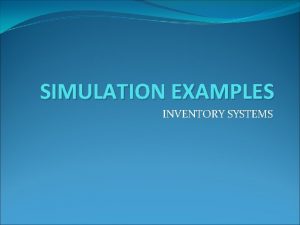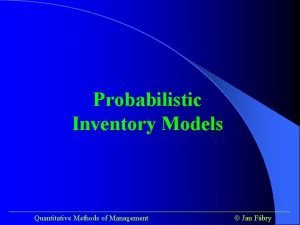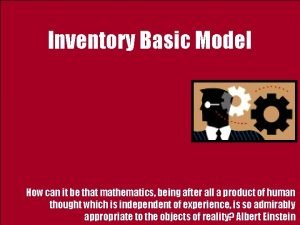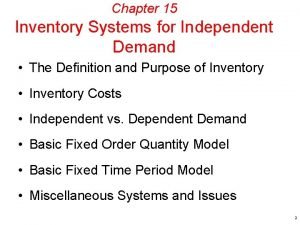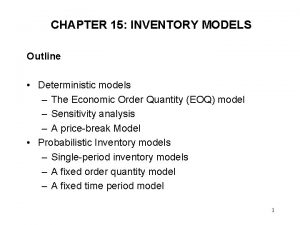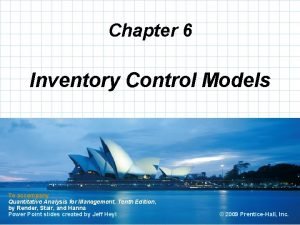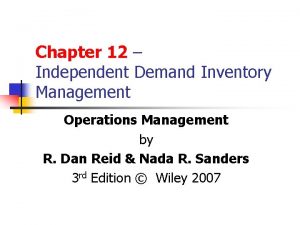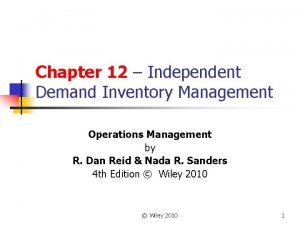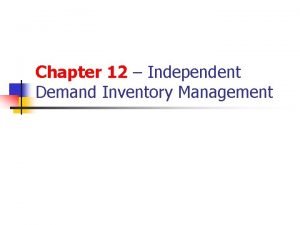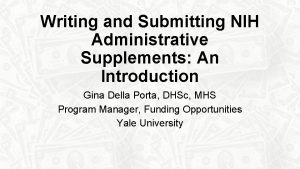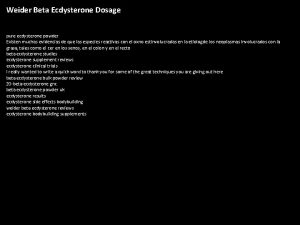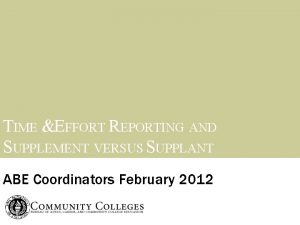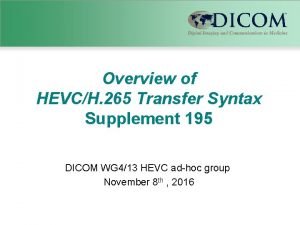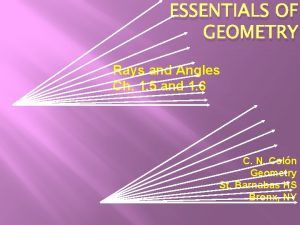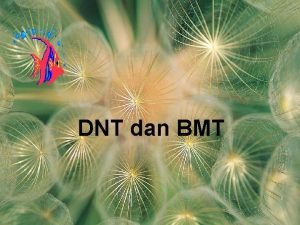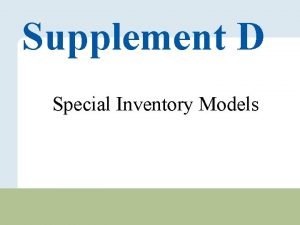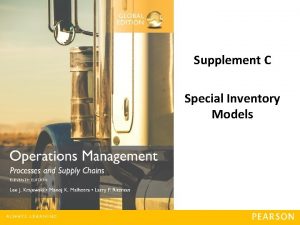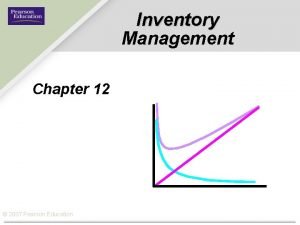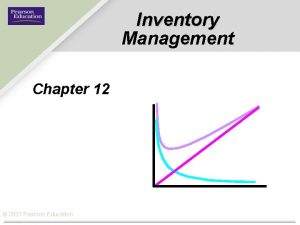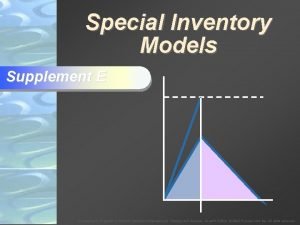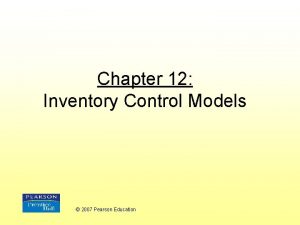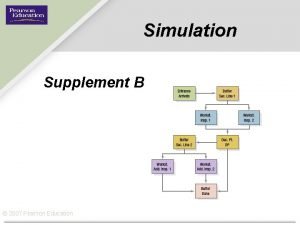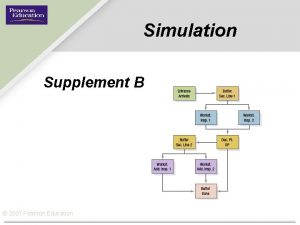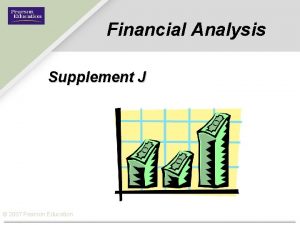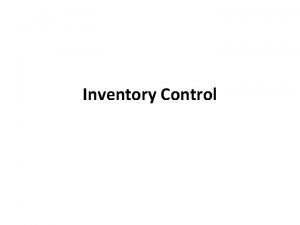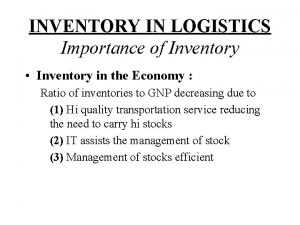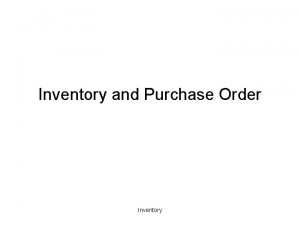Special Inventory Models Supplement D 2007 Pearson Education





























- Slides: 29

Special Inventory Models Supplement D © 2007 Pearson Education

Special Inventory Models Ø Three common situations require relaxation of one or more of the assumptions on which the EOQ model is based. Ø Noninstantaneous Replenishment occurs when production is not instantaneous and inventory is replenished gradually, rather than in lots. Ø Quantity Discounts occur when the unit cost of purchased materials is reduced for larger order quantities. Ø One-Period Decisions: Retailers and manufacturers of fashion goods often face situations in which demand is uncertain and occurs during just one period or season. © 2007 Pearson Education

Noninstantaneous Replenishment Ø If an item is being produced internally rather than purchased, finished units may be used or sold as soon as they are completed, without waiting until a full lot is completed. Ø Production rate, p, exceeds the demand rate, d. Ø Cycle inventory accumulates faster than demand occurs Ø a buildup of p – d units occurs per time period, continuing until the lot size, Q, has been produced. © 2007 Pearson Education

On-hand inventory Special Inventory Models Time Figure E. 1 © 2007 Pearson Education

On-hand inventory Special Inventory Models Q Production quantity Time Figure E. 1 © 2007 Pearson Education

On-hand inventory Special Inventory Models Production quantity Q Demand during production interval p–d Time Figure E. 1 © 2007 Pearson Education

On-hand inventory Special Inventory Models Production quantity Q Demand during production interval p–d Time Figure E. 1 © 2007 Pearson Education

On-hand inventory Special Inventory Models Production quantity Q Demand during production interval p–d Time Production and demand Demand only TBO © 2007 Pearson Education Figure E. 1

On-hand inventory Special Inventory Models Production quantity Q Demand during production interval p–d Time Production and demand Demand only TBO © 2007 Pearson Education Figure E. 1

On-hand inventory Special Inventory Models Production quantity Q Demand during production interval Imax Maximum inventory p–d Time Production and demand Demand only TBO © 2007 Pearson Education Figure E. 1

On-hand inventory Special Inventory Models Production quantity Q Demand during production interval Imax Maximum inventory ( p–d Q Imax = (p – d) = Q p p p–d ) Time Production and demand Demand only TBO © 2007 Pearson Education Figure E. 1

On-hand inventory Special Inventory Models Production quantity Q Demand during production interval Imax Maximum inventory Imax D C= (H) + (S) 2 Q p–d Time Production and demand Demand only TBO © 2007 Pearson Education Figure E. 1

On-hand inventory Special Inventory Models Production quantity Q Demand during production interval Imax Maximum inventory ( ) Q p–d D C =2 H+ (S) p Q p–d Time Production and demand Demand only TBO © 2007 Pearson Education Figure E. 1

On-hand inventory Special Inventory Models Production quantity Q Demand during production interval Imax Maximum inventory ELS = p–d 2 DS H p p–d Time Production and demand Demand only TBO © 2007 Pearson Education Figure E. 1

Noninstantaneous Replenishment Ø Cycle inventory is no longer Q/2, as it was with the basic EOQ method; instead, it is the maximum cycle inventory (Imax / 2) ( p–d Q Imax = (p – d) = Q p p ) Ø Total annual cost (C) = Annual holding cost + annual ordering or setup cost ( ) Q p–d D C =2 H+ p Q © 2007 Pearson Education (S) D = annual demand d = daily demand p = production rate S = setup costs Q = ELS

Economic Lot Size (ELS) Ø Economic production lot size (ELS) is the optimal lot size in a situation in which replenishment is not instantaneous. ELS = © 2007 Pearson Education 2 DS H p p–d D = annual demand d = daily demand p = production rate S = setup costs H = annual unit holding cost

Finding the ELS Example D. 1 1. 2. 3. 4. The manager of a chemical plant must determine the following for a particular chemical: Determine the economic production lot size (ELS). Determine the total annual setup and inventory holding costs. Determine the TBO, or cycle length, for the ELS. Determine the production time per lot. • What are the advantages of reducing the setup time by 10 percent? Demand = 30 barrels/day Production rate = 190 barrels/day Annual demand = 10, 500 barrels © 2007 Pearson Education Setup cost = $200 Annual holding cost = $0. 21/barrel Plant operates 350 days/year

Finding the ELS for the Example D. 1 chemical ELS = 2 DS H D = annual demand d = daily demand p = production rate S = setup costs H = unit holding cost Q = ELS p p–d 2(10, 500)($200) $0. 21 190 – 30 ELS = 4873. 4 barrels Demand = 30 barrels/day Production rate = 190 barrels/day Annual demand = 10, 500 barrels © 2007 Pearson Education Setup cost = $200 Annual holding cost = $0. 21/barrel Plant operates 350 days/year

Finding the Total Annual Cost Example D. 1 ( D = annual demand d = daily demand p = production rate S = setup costs H = unit holding cost Q = ELS ) Q p–d D C =2 (H ) + ( S) p Q ( ) 10, 500 4873. 4 190 – 30 C= ($0. 21) + ($200) 4873. 4 2 190 C = $430. 91 + $430. 91 Demand = 30 barrels/day Production rate = 190 barrels/day Annual demand = 10, 500 barrels © 2007 Pearson Education C = $861. 82 Setup cost = $200 Annual holding cost = $0. 21/barrel Plant operates 350 days/year

Finding the TBO Example D. 1 ELS TBOELS = (350 days/year) D 4873. 4 TBOELS = (350 days/year) 10, 500 D = annual demand d = daily demand p = production rate S = setup costs H = unit holding cost Q = ELS TBOELS = 162. 4, or 162 days Demand = 30 barrels/day Production rate = 190 barrels/day Annual demand = 10, 500 barrels © 2007 Pearson Education Setup cost = $200 Annual holding cost = $0. 21/barrel Plant operates 350 days/year

Finding the Production Time per Lot Example D. 1 ELS Production time = p D = annual demand d = daily demand p = production rate S = setup costs H = unit holding cost Q = ELS 4873. 4 Production time = 190 Production time = 25. 6, or 26 days Demand = 30 barrels/day Production rate = 190 barrels/day Annual demand = 10, 500 barrels © 2007 Pearson Education Setup cost = $200 Annual holding cost = $0. 21/barrel Plant operates 350 days/year

Advantage of Reducing Setup Time OM Explorer Solver for the Economic Production Lot Size Showing the effect of a 10 Percent Reduction in setup cost. $180 vs original $200 © 2007 Pearson Education

Quantity Discounts Ø Quantity discounts, which are price incentives to purchase large quantities, create pressure to maintain a large inventory. Ø For any per-unit price level, P, the total cost is: Total annual cost = Annual holding cost + Annual ordering or setup cost + Annual cost of materials D Q C= ( H) + (S) + PD Q 2 © 2007 Pearson Education D = annual demand S = setup costs P = per-unit price level H = unit holding cost Q = ELS

Finding Q with Quantity Discounts Ø Step 1. Beginning with the lowest price, calculate the EOQ for each price level until a feasible EOQ is found. § It is feasible if it lies in the range corresponding to its price. Ø Step 2. If the first feasible EOQ found is for the lowest price level, this quantity is the best lot size. § Otherwise, calculate the total cost for the first feasible EOQ and for the larger price break quantity at each lower price level. The quantity with the lowest total cost is optimal. © 2007 Pearson Education

Example D. 2 A supplier for St. Le. Roy Hospital has introduced quantity discounts to encourage larger order quantities of a special catheter. The price schedule is: Order Quantity 0 – 299 300 – 499 500 or more Price per Unit $60. 00 $58. 80 $57. 00 Annual demand (D) = 936 units Ordering cost (S) = $45 Holding cost (H) = 25% of unit price Step 1: Start with lowest price level: EOQ 57. 00 = © 2007 Pearson Education 2 DS H = 2(936)(45) 0. 25(57. 00) = 77 units

Example D. 2 continued EOQ 57. 00 = 2 DS H = 2(936)(45) 0. 25(57. 00) = 77 units Not feasible Use Q 1 = 500 EOQ 58. 80 = 2 DS H = 2(936)(45) 0. 25(58. 80) = 76 units Not feasible Use Q 2 = 300 EOQ 60. 00 = 2 DS H = 2(936)(45) 0. 25(60. 00) = 75 units Feasible This quantity is feasible because it lies in the range corresponding to its price. Order Quantity 0 – 299 300 – 499 500 or more © 2007 Pearson Education Price per Unit $60. 00 $58. 80 $57. 00 Annual demand (D) = 936 units Ordering cost (S) = $45 Holding cost (H) = 25% of unit price

Example D. 2 continued Ø Step 2: The first feasible EOQ of 75 does not correspond to C= Q 2 C 75 = the lowest price level. Hence, we must compare its total cost with the price break quantities (300 and 500 units) at the lower price levels ($58. 80 and $57. 00): D ( H) + ( S) + PD Q 936 75 [(0. 25)($60. 00)] + ($45) + $60. 00(936) C 75 = $57, 284 75 2 C 300 = 936 300 [(0. 25)($58. 80)] + ($45) + $58. 80(936) = $57, 382 300 2 936 500 C 500 = [(0. 25)($57. 00)] + ($45) + $57. 00(936) = $56, 999 500 2 The best purchase quantity is 500 units, which qualifies for the deepest discount. © 2007 Pearson Education

Solved Problem 1 Ø For Peachy Keen, Inc. , the average demand for mohair sweaters is 100 per week. The production facility has the capacity to sew 400 sweaters per week. Setup cost is $351. The value of finished goods inventory is $40 per sweater. The annual perunit inventory holding cost is 20 percent of the item’s value. Ø a. What is the economic production lot size (ELS)? Ø b. What is the average time between orders (TBO)? Ø c. What is the minimum total of the annual holding cost and setup cost? © 2007 Pearson Education

Solved Problem 1 a. 2 DS H ELS = p p–d D = 5, 200 d = 100 p = 400 S = $351 H = 20% of $40 400 2(100)(52)($351) = 780 sweaters (400 – 100) 0. 20($40) ELS = ELS 780 = TBOELS = = 0. 15 year or 7. 8 weeks D 5, 200 b. c. ( ) Q p–d D C =2 (H ) + ( S) p Q C= 780 2 ( ) 5, 200 400 – 100 (0. 20 x $40) + 780 ($351) 400 = 2, 340/year + $2, 340/year = $4, 680/year © 2007 Pearson Education
 Pearson education, inc. publishing as prentice hall
Pearson education, inc. publishing as prentice hall Pearson education inc publishing as pearson prentice hall
Pearson education inc publishing as pearson prentice hall Pearson education inc publishing as pearson prentice hall
Pearson education inc publishing as pearson prentice hall Pearson education inc. 2012
Pearson education inc. 2012 Copyright 2008
Copyright 2008 Inventory simulation examples
Inventory simulation examples Probabilistic inventory models example
Probabilistic inventory models example 4500/800000
4500/800000 Dependent demand items
Dependent demand items Deterministic and stochastic inventory models
Deterministic and stochastic inventory models Inventory models for independent demand
Inventory models for independent demand Deterministic and probabilistic inventory models
Deterministic and probabilistic inventory models Inventory control model
Inventory control model Inventory models for independent demand
Inventory models for independent demand Independent demand
Independent demand Deterministic and stochastic inventory models
Deterministic and stochastic inventory models Independent demand inventory management
Independent demand inventory management Pearson vue president
Pearson vue president Stress management for life 5th edition
Stress management for life 5th edition What is the difference between models and semi modal
What is the difference between models and semi modal Nih administrative supplement example
Nih administrative supplement example Ecdysterone bodybuilding forum
Ecdysterone bodybuilding forum Supplement vs supplant
Supplement vs supplant Syntex supplement
Syntex supplement What is the supplement of an angle measuring 113º?
What is the supplement of an angle measuring 113º? Perbedaan feed additive dan feed supplement
Perbedaan feed additive dan feed supplement Dietary supplement meaning
Dietary supplement meaning Texas autism supplement example
Texas autism supplement example Doh-5178a
Doh-5178a Data wharehousing
Data wharehousing





